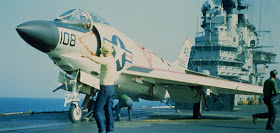One notable feature of the Navy's gray/white paint scheme was the red identification of crush* points: flaps, slats, speed brakes, and landing gear doors. Except it was not always so. In this picture, reportedly taken in May 1960, neither the A4D-2 nor the F4D-1 have red-painted slat wells or red-edged landing gear doors.
(Also note that the F4D has probably been pushed back into its parking place, since the nose wheel is facing backwards.)
In fact, it is fairly rare to see any pictures of the F4D with red in the slat wells and very rare to see one with red edges on the landing gear doors (except for one restored for a museum). This one was photographed at the Paris Air Show in May/June 1961 as confirmed by Bernard Thouanel. The only obvious red is on the edges of the wing at the fold joint but there does appear to be red on the wing that would be covered when the slat closed (but definitely not on the edge of wing inboard of the slat).
Note the inflight refueling probe that has been added to the left drop tank, a change adopted fairly late in the F4D's career.
However, there are clear examples of later F4Ds with red-painted slat wells:
The Navy began the change from overall blue to gray/white in February 1955 (see http://tailspintopics.blogspot.com/2009/12/changing-from-blue-to-graywhite.html). At the time, the interior surfaces of speed brakes and wing flaps and their wells were to be painted red, according to Mil-C-18263 dated 23 February 1955. The interior of slats and their wells was added by Mil-C-18263A dated 16 July 1956, although this was reportedly "released at a later date." Red on the edges of doors was decreed by revision B of Mil-C-18263 dated 12 February 1959.
So how come, assuming that the date given with the photo is correct, do those airplanes have grey slat wells and all white gear doors? The answer is probably that it takes time to revise contracts in the case of the manufacturers, and create the requisite documentation in the case of the government repair and overhaul facilities. With that in mind, these changes were generally issued with a generous amount of time before compliance was required.
And even then there are examples where the main gear doors have a red edge and the nose gear doors do not.
It would appear that the A4D Skyhawk didn't have red edges on the gear doors before 1961. Color photographs suggest that the slat wells were painted red before the gear-door edges began to be painted red, so if the slats aren't red, then it's likely that the gear-door edges weren't either.
Some other interesting examples:
Note that the A-4 on the left has red slat wells (and you may not be able to see it, but the gear doors are not red-edged) while the one on the right does not. (The airplanes are from two different squadrons; in general, the maintenance officer of a squadron liked to have all of his charges be from the same overhaul batch so they were identical in configuration.)
The slat wells weren't always red (however, this is the only example I've seen).
The speed brake wells (or flap cove for that matter) weren't necessarily red even though the interior of the speed brake was.
One interesting aspect of this requirement is that McDonnell painted crush points red from the beginning, and not just the edges of the landing gear door but the whole door.
North American and/or the Navy also appears to have painted the interior of the landing gear doors on some FJ-3 and FJ-4 Furys red.
* Rick Morgan reminded me of a reason, maybe the reason, for all that red: "When I was in TRACOM we were told that the red edges to door was so that you could quickly see if one wasn’t seated properly in flight, usually while checking a wingee with an unsafe ‘up’ indication. The red under the slats also helped determine that they were deploying properly as you slowed down; an A-3 with a stuck slat could be catastrophic; you really had to pay attention to them while slowing down... Likewise red speed brakes were great indication that they were moving (always exciting when lead forgot to warn you while descending a section in weather) Never thought over-all red was a good idea; it made hydraulic leaks harder to see."














Rick's comment reminds me of what one of our instructors (a long-retired CPO) taught one day when going through basic aircraft mechanic school: all-red doors etc. were a real headache during maintenance on the carriers. Maintenance was often carried out at night after flight-ops were done, on a hangar deck with red lighting. So the mech would have been looking for a leak by trying to find red fluid, on a red surface, in a room illuminated by red lighting. Apparently it made things "difficult".
ReplyDelete